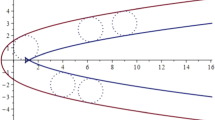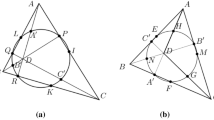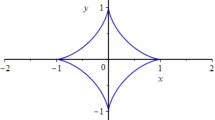Abstract
Cassini ovals (also called spiric curves or Spirics of Perseus) are an interesting family of bicircular quartic plane curves, appearing in various scientific fields, such as electric fields and delineation of influence zones of wells. They appear also as bisoptic curves of ellipses and, with some additional conditions, of hyperbolas. They provide connections between conic sections (intersection of a plane with a cone) and toric sections (intersection of a plane with a torus) with simultaneous manipulations on plane curves and surfaces in 3D. In general, Cassini ovals are presented as having one component, but the exploration of bisoptic curves of ellipses showed that despite the irreducibility of the polynomial, the curve is the union of two components, which cannot be distinguished by pure real algebraic methods. One of the components may have points of inflexion, and the other not. Networking between a computer algebra system and a dynamic geometry system, we explore the existence of these flexes, using the Hessian curve of the spiric, which is also a spiric. This exploration involves two tori. The work is also a new contribution about transition from 2D to 3D, and also to working in 2D and 3D together. The final section is devoted to educative remarks: on the one hand, the general issue of a multi-tools instrumental genesis and, on the other hand, the decision to study plane curves in a technology-rich environment. Collaboration between different kinds of software, including communication software has been reinforced by need of distance learning during the Covid-19 period.











Similar content being viewed by others
Notes
Offsets appear also in architecture; see [21].
Freely downloadable from http://www.geogebra.org.
The polynomial equation describes both components, which are not distinguished by algebraic means, whence the name bisoptic for the curve.
The reader can try this with a web applet. Recall that a construction with GeoGebra is based on free points and other objects, such as lines, circles, etc., may depend on these free points. Dragging (i.e. moving) a free point using the mouse induces changes in the dependent objects. These changes can be observed and analyzed; see [32] for a full study of the benefits of dragging points.
For example Chijner’s applets such as https://www.geogebra.org/m/krmmnhu4#material/vttusatf.
For example, http://mathcurve.com, and https://mathshistory.st-andrews.ac.uk/Curves/.
References
Abate, M., Tovana, F.: Curves and Surfaces. Springer Verlag Italia, Milan (2012)
Artigue, M.: Learning mathematics in a CAS environment: the Genesis of a reflection about instrumentation and the dialectics between technical and conceptual work. Int. J. Comput. Math. Learn. 7(3), 245–274 (2002). https://doi.org/10.1023/A:1022103903080
Brieskorn, E., Knörrer, H.: Plane Algebraic Curves. Birkhauser, Switzerland (1986)
Bruce, J.W., Giblin, P.J.: Curves and Singularitites. Cambridge University Press, Cambridge (1984)
Cagnac, G., Ramis, E., Commeau, J, J.: Nouveau cours de Mathématiques Spéciales, Masson & Cie, Paris, (1965)
Cox, D., Little, J., O’Shea, D.: Ideals, Varieties, and Algorithms: An Introduction to Computational Algebraic Geometry and Commutative Algebra. Undergraduate Texts in Mathematics, Springer, Berlin (1992)
Dana-Picard, T.: The isoptics of an astroid. J. Symb. Comput. 97, 56–68 (2020)
Dana-Picard, T.: A STEAM approach to canal surfaces. Electron. J. Technol. Math. 17(3), 206–224 (2023)
Dana-Picard, T., Hershkovitz, S.: STEAM education: technological skills, students’ cultural background and Covid-19 crisis. Open Educ. Stud. 2(1), 171–179 (2020)
Dana-Picard, T., Kovács, Z.: Automated determination of isoptics with dynamic geometry, in Intelligent Computer Mathematics (F. Rabe, W. Farmer, G. Passmore, A. Youssef , Eds.), Lecture Notes in Artificial Intelligence (a subseries of Lecture Notes in Computer Science) 11006, Springer, pp 60-75 (2018)
Dana-Picard, T., Kovács, Z.: Offsets of a regular trifolium, arXiv:2107.14592. To appear in the bulletin of the “Sociedad Matemática Puig Adam” (2021)
Dana-Picard, T., Mann, G., Zehavi, N.: From conic intersections to toric intersections: the case of the isoptic curves of an ellipse. Montana Math. Enthusiast 9(1), 59–76 (2011)
Dana-Picard, T., Recio, T.: Dynamic construction of a family of octic curves as geometric loci. AIMS Math. 8(8), 19461–19476 (2023)
Dana-Picard, T., Zehavi, N., Mann, G.: Bisoptic curves of hyperbolas. Int. J. Math. Educ. Sci. Technol. 45(5), 762–781 (2014)
Dana-Picard, T., Zehavi, N.: Automated study of envelopes: the transition from 2D to 3D. Electron. J. Math. Technol. 13(2), 121–135 (2019)
Dana-Picard, T., Naiman, A., Mozgawa, W., Cieślak, V.: Exploring the isoptics of Fermat curves in the affine plane using DGS and CAS. Math. Comput. Sci. 14, 45–67 (2020)
Dana-Picard, T., Kovács, Z.: Networking of technologies: a dialog between CAS and DGS. Electron. J. Math. Technol. 15(1), 43–59 (2021)
Dana-Picard, T., Kovács, Z. Z.: Offsets of a regular trifolium, to appear in the bulletin of the “Sociedad Matemática Puig Adam” , 2021. http://arxiv.org/abs/2107.14592
Dana-Picard, T., Kovács, Z.: Offsets of Cassini ovals, to appear. Electron. J. Math. Technol. (eJMT), (2022)
Duval, R.: Semiosis et pensée humaine. Peter Lang, Bern (1995)
Eversmann, P., Ehret, P., Louter, C., Santarsiero, M.: Appliction of hybrid glass-timber elements in archtecture: semi continuous and self-generative glass layering structural system, in P. Block, J. Knippers, N. Mitra and W. Wang (edts) Advances in Architetural Geometry 2014, Springer, pp. 47-60, (2015)
Fischer, G.: Plane Algebraic Curves, Student Mathematical Library 15, AMS. Providence, RI (2009)
Harris, J.: Geometry of Algebraic Curves, Lectures delivered in Harvard 2011, Notes by A. Atanasov, retrieved October 2021 from https://staff.math.su.se/shapiro/UIUC/curvesHarris.pdf
Dennis Lawrence, J.: A catalog of special plane curves. Dover, NY (1972)
Ferréol, R. R.: Quartiques bicirculaires, available: http://www.mathcurve.com/courbes2d/quarticbicirculaire/quarticbicirculaire.shtml (2001)
Kirwan, F.: Complex Algebraic Curves, London Mathematical Society Student Texts 23, Cambridge University Press, 1992 (2nd edition 2012)
Kovács, Z.: Achievements and challenges in automatic locus and envelope animations in dynamic geometry. Math. Comput. Sci. 13, 131–141 (2019)
Kovács, Z., Parisse, B.: Giac and GeoGebra-improved Gröbner basis computations” In: Computer Algebra and Polynomials, Lecture Notes in Computer Science8942 , 126-138 (2015)
Miernowski, A., Mozgawa, W.: Isoptics of pairs of nested closed strictly convex curves and crofton-type formulas. Beiträge zur Algebra und Geom. Contrib. Algebra Geom. 42(1), 281–288 (2001)
Monge, G.: Leçons de géométrie descriptive, Paris: Beaudoin an VII (1798); re-edited by Jacques Gabay. Sceaux, France (1989)
Montes, A.: The Gröbner Cover, Algorithms and Computations in Mathematics 27. Springer, Berlin (2018)
Selaković, M., Marinković, V., Janičić, P.: New dynamics in dynamic geometry: dragging constructed points. J. Symbol. Comput. 97, 3–15 (2020)
Skrzypiec, M.: Convexity limit angles for isoptics. Beiträge Algebra Geom. (2021). https://doi.org/10.1007/s13366-021-00564-5
Ritella, G., Hakkarainen, K.: Instrumental genesis in technology-mediated learning: from double stimulation to expansive knowledge practices. Int. J. Comput.-Support. Collab. Learn. 7(2), 239–258 (2012)
Roanes-Lozano, E., Roanes-Macias, E.: A bridge between dynamic geometry and computer algebra. Math. Comput. Model. 37, 1005–1028 (2003)
Szałkowski, D.: Isoptics of open rosettes, pp. 119–128. Annales Universitatis Mariae Curie- Skłodowska, Lublin - Polonia LIX, Section A (2005)
Trouche, L.: Instrumentation in Mathematics Education. Encyclop. Math. Educ. (2014). https://doi.org/10.1007/978-94-007-4978-8_80
Vygotsky, L.S.: Mind in society: The development of higher psychological processes. Harvard University Press, Cambridge, MA (1978)
Wall, C.: Singular points of plane curves, London Mathematical Society Student Texts 63. Cambridge University Press, Cambridge (2004)
Yerushalmy, M.: Challenging known transitions: learning and teaching algebra with technology. For the Learn. Math. 2, 37–42 (2005)
Zeitoun, D., Dana-Picard, Th.: Accurate visualization of graphs of functions of two real variables. Int. J. Comput. Math. Sci. 4(1), 1–11 (2010)
Zeitoun, D., Dana-Picard, Th.: Delineation of the zone of influence of pumping wells using CAS and DGS, to appear in Electronic Proceedings of the Asian Conference on Technology in Mathematics ACTM 2021, Mathematics and Technology (2022)
Zimmermann, E.: The 4 C’s of Learning in a Connected Classroom, EdTech Magazine, retrieved in October 2021: https://edtechmagazine.com/k12/article/2018/07/4-cs-learning-connected-classroom
Acknowledgements
This work has been partially supported by the CEMJ Chair at JCT.
Author information
Authors and Affiliations
Corresponding author
Additional information
Publisher's Note
Springer Nature remains neutral with regard to jurisdictional claims in published maps and institutional affiliations.
Rights and permissions
Springer Nature or its licensor (e.g. a society or other partner) holds exclusive rights to this article under a publishing agreement with the author(s) or other rightsholder(s); author self-archiving of the accepted manuscript version of this article is solely governed by the terms of such publishing agreement and applicable law.
About this article
Cite this article
Dana-Picard, T. Inflexions of Spiric Curves: A Tale of Two Tori. Math.Comput.Sci. 18, 2 (2024). https://doi.org/10.1007/s11786-024-00578-x
Received:
Revised:
Accepted:
Published:
DOI: https://doi.org/10.1007/s11786-024-00578-x
Keywords
- Spiric curves
- Cassini ovals
- Toric intersections
- Inflexions
- Hessian curves
- Dynamic geometry
- Computer algebra systems




